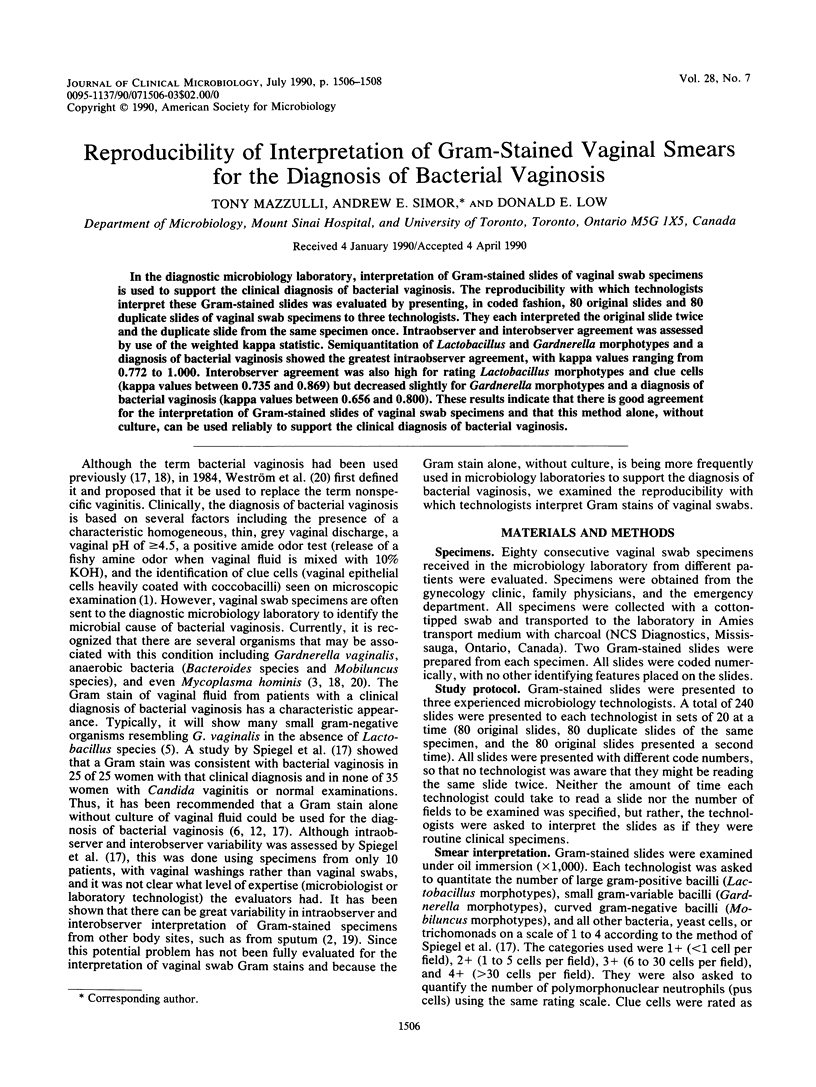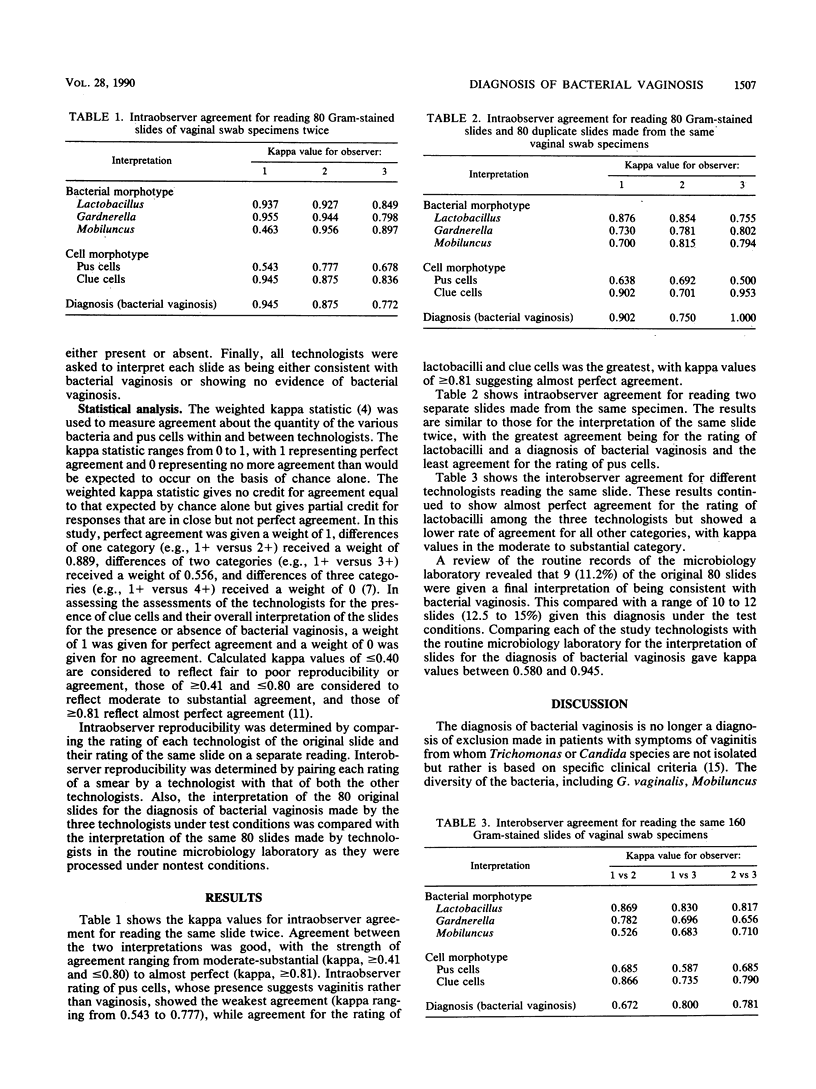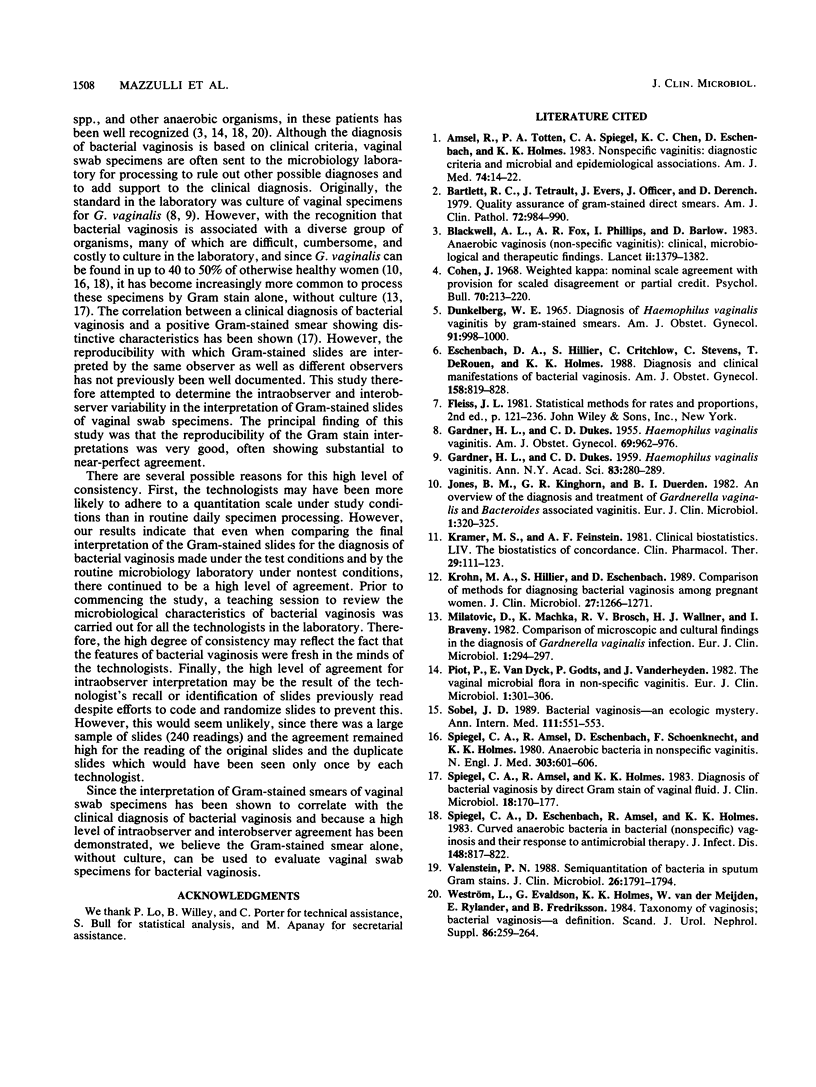Abstract
In the diagnostic microbiology laboratory, interpretation of Gram-stained slides of vaginal swab specimens is used to support the clinical diagnosis of bacterial vaginosis. The reproducibility with which technologists interpret these Gram-stained slides was evaluated by presenting, in coded fashion, 80 original slides and 80 duplicate slides of vaginal swab specimens to three technologists. They each interpreted the original slide twice and the duplicate slide from the same specimen once. Intraobserver and interobserver agreement was assessed by use of the weighted kappa statistic. Semiquantitation of Lactobacillus and Gardnerella morphotypes and a diagnosis of bacterial vaginosis showed the greatest intraobserver agreement, with kappa values ranging from 0.772 to 1.000. Interobserver agreement was also high for rating Lactobacillus morphotypes and clue cells (kappa values between 0.735 and 0.869) but decreased slightly for Gardnerella morphotypes and a diagnosis of bacterial vaginosis (kappa values between 0.656 and 0.800). These results indicate that there is good agreement for the interpretation of Gram-stained slides of vaginal swab specimens and that this method alone, without culture, can be used reliably to support the clinical diagnosis of bacterial vaginosis.
Full text
PDF


Selected References
These references are in PubMed. This may not be the complete list of references from this article.
- Amsel R., Totten P. A., Spiegel C. A., Chen K. C., Eschenbach D., Holmes K. K. Nonspecific vaginitis. Diagnostic criteria and microbial and epidemiologic associations. Am J Med. 1983 Jan;74(1):14–22. doi: 10.1016/0002-9343(83)91112-9. [DOI] [PubMed] [Google Scholar]
- Bartlett R. C., Tetreault J., Evers J., Officer J., Derench J. Quality assurance of gram-stained direct smears. Am J Clin Pathol. 1979 Dec;72(6):984–989. doi: 10.1093/ajcp/72.6.984. [DOI] [PubMed] [Google Scholar]
- Blackwell A. L., Fox A. R., Phillips I., Barlow D. Anaerobic vaginosis (non-specific vaginitis): clinical, microbiological, and therapeutic findings. Lancet. 1983 Dec 17;2(8364):1379–1382. doi: 10.1016/s0140-6736(83)90920-0. [DOI] [PubMed] [Google Scholar]
- DUNKELBERG W. E., Jr DIAGNOSIS OF HEMOPHILUS VAGINALIS VAGINITIS BY GRAM-STAINED SMEARS. Am J Obstet Gynecol. 1965 Apr 1;91:998–1000. doi: 10.1016/0002-9378(65)90569-7. [DOI] [PubMed] [Google Scholar]
- Eschenbach D. A., Hillier S., Critchlow C., Stevens C., DeRouen T., Holmes K. K. Diagnosis and clinical manifestations of bacterial vaginosis. Am J Obstet Gynecol. 1988 Apr;158(4):819–828. doi: 10.1016/0002-9378(88)90078-6. [DOI] [PubMed] [Google Scholar]
- GARDNER H. L., DUKES C. D. Haemophilus vaginalis vaginitis: a newly defined specific infection previously classified non-specific vaginitis. Am J Obstet Gynecol. 1955 May;69(5):962–976. [PubMed] [Google Scholar]
- GARDNER H. L., DUKES C. D. Hemophilus vaginalis vaginitis. Ann N Y Acad Sci. 1959 Nov 18;83:280–289. doi: 10.1111/j.1749-6632.1960.tb40901.x. [DOI] [PubMed] [Google Scholar]
- Jones B. M., Kinghorn G. R., Duerden B. I. An overview of the diagnosis and treatment of Gardnerella vaginalis and Bacteroides associated vaginitis. Eur J Clin Microbiol. 1982 Oct;1(5):320–325. doi: 10.1007/BF02019980. [DOI] [PubMed] [Google Scholar]
- Kramer M. S., Feinstein A. R. Clinical biostatistics. LIV. The biostatistics of concordance. Clin Pharmacol Ther. 1981 Jan;29(1):111–123. doi: 10.1038/clpt.1981.18. [DOI] [PubMed] [Google Scholar]
- Krohn M. A., Hillier S. L., Eschenbach D. A. Comparison of methods for diagnosing bacterial vaginosis among pregnant women. J Clin Microbiol. 1989 Jun;27(6):1266–1271. doi: 10.1128/jcm.27.6.1266-1271.1989. [DOI] [PMC free article] [PubMed] [Google Scholar]
- Milatovic D., Machka K., Brosch R. V., Wallner H. J., Braveny I. Comparison of microscopic and cultural findings in the diagnosis of Gardnerella vaginalis infection. Eur J Clin Microbiol. 1982 Oct;1(5):294–297. doi: 10.1007/BF02019974. [DOI] [PubMed] [Google Scholar]
- Piot P., Van Dyck E., Godts P., Vanderheyden J. The vaginal microbial flora in non-specific vaginitis. Eur J Clin Microbiol. 1982 Oct;1(5):301–306. doi: 10.1007/BF02019976. [DOI] [PubMed] [Google Scholar]
- Sobel J. D. Bacterial vaginosis--an ecologic mystery. Ann Intern Med. 1989 Oct 1;111(7):551–553. doi: 10.7326/0003-4819-111-7-551. [DOI] [PubMed] [Google Scholar]
- Spiegel C. A., Amsel R., Eschenbach D., Schoenknecht F., Holmes K. K. Anaerobic bacteria in nonspecific vaginitis. N Engl J Med. 1980 Sep 11;303(11):601–607. doi: 10.1056/NEJM198009113031102. [DOI] [PubMed] [Google Scholar]
- Spiegel C. A., Amsel R., Holmes K. K. Diagnosis of bacterial vaginosis by direct gram stain of vaginal fluid. J Clin Microbiol. 1983 Jul;18(1):170–177. doi: 10.1128/jcm.18.1.170-177.1983. [DOI] [PMC free article] [PubMed] [Google Scholar]
- Spiegel C. A., Eschenbach D. A., Amsel R., Holmes K. K. Curved anaerobic bacteria in bacterial (nonspecific) vaginosis and their response to antimicrobial therapy. J Infect Dis. 1983 Nov;148(5):817–822. doi: 10.1093/infdis/148.5.817. [DOI] [PubMed] [Google Scholar]
- Valenstein P. N. Semiquantitation of bacteria in sputum gram stains. J Clin Microbiol. 1988 Sep;26(9):1791–1794. doi: 10.1128/jcm.26.9.1791-1794.1988. [DOI] [PMC free article] [PubMed] [Google Scholar] [Retracted]


